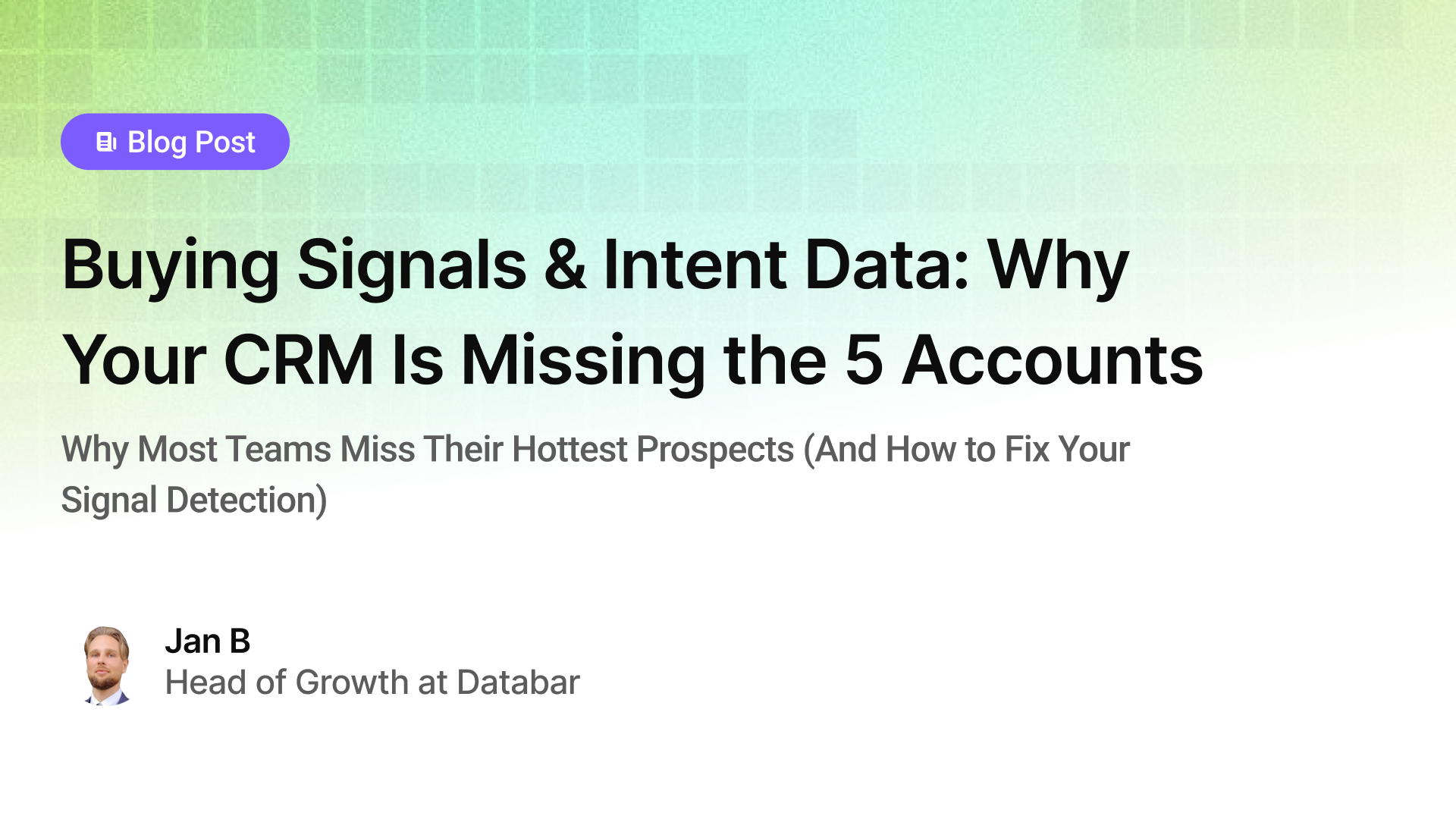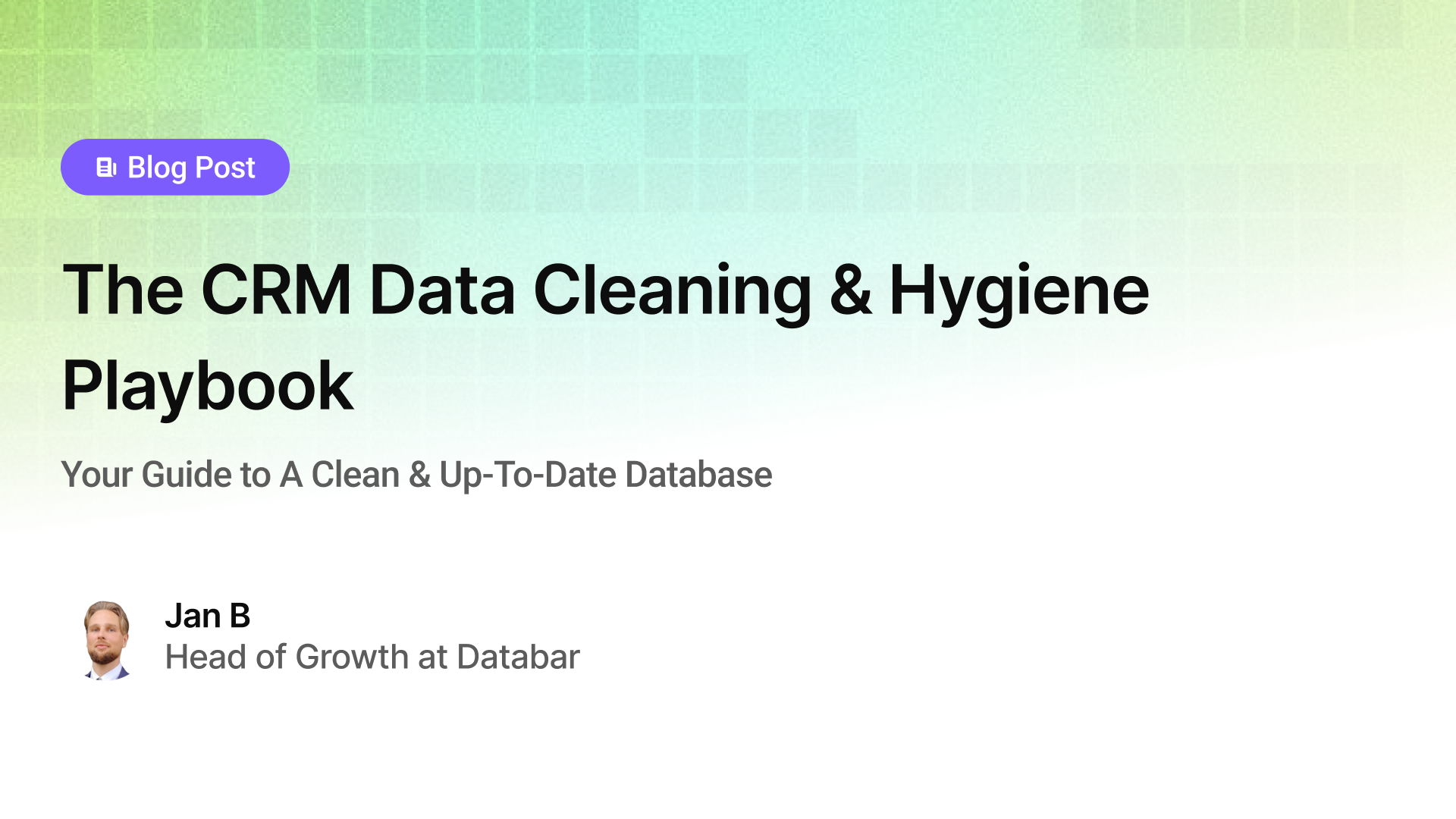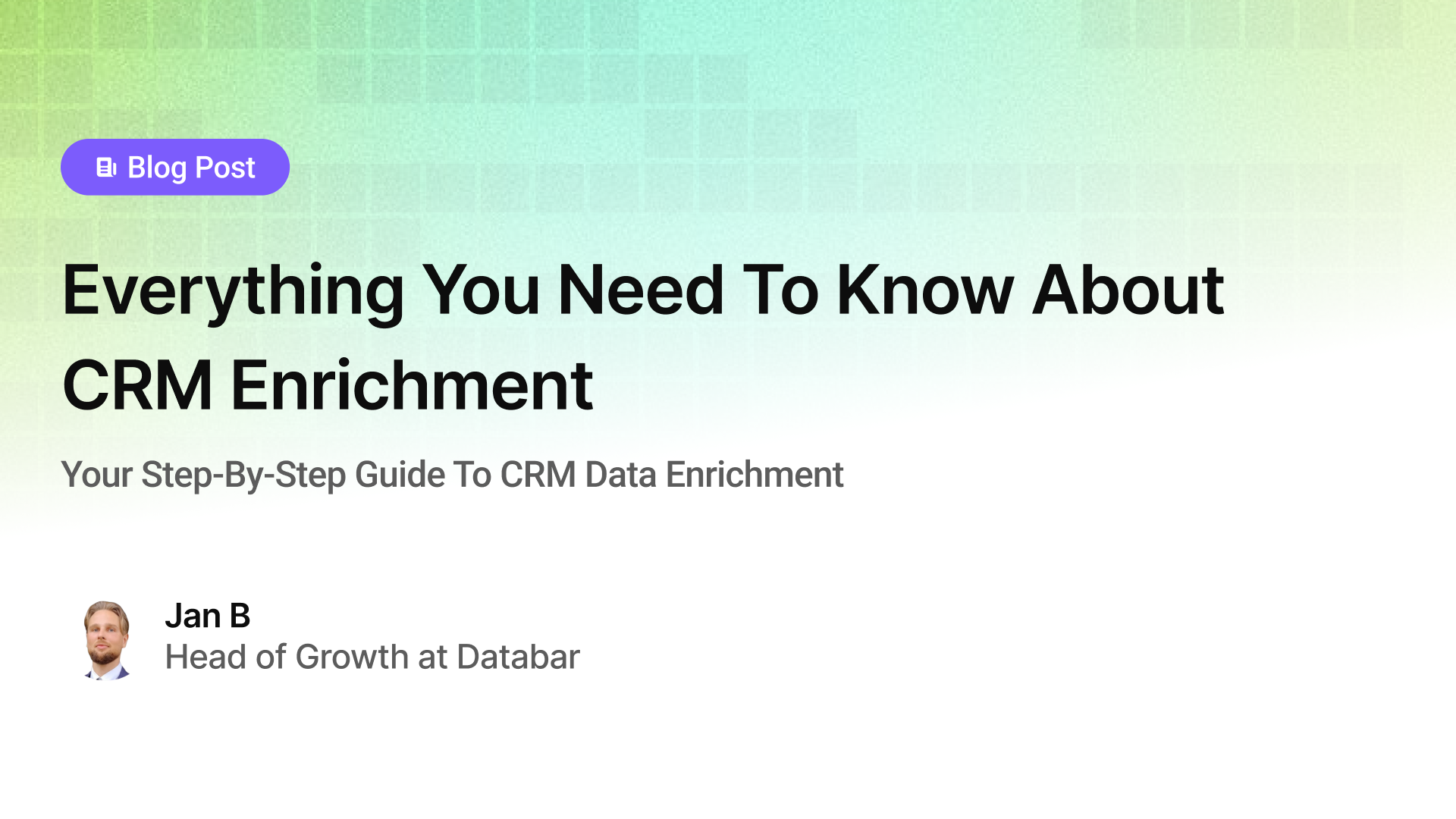Company Data Enrichment: Firmographic Intelligence at Scale
Turn Basic Company Data into Actionable Insights That Fuel Your GTM Engine
Blogby JanJune 30, 2025

Quick Summary: Company data enrichment turns basic business information into comprehensive firmographic intelligence. This guide shows you exactly how to build scalable enrichment workflows that give your GTM teams the insights they need to close more deals faster.
What You'll Learn:
- The 7 essential firmographic data points that drive revenue
- How to build automated enrichment workflows at scale
- Real-world examples of enrichment in action
- Common pitfalls and how to avoid them
- Step-by-step implementation guide
Ever wonder why some sales teams consistently hit 150% of quota while others struggle to reach 80%?
The difference often comes down to one thing: the quality of their company intelligence.
Last week, I talked to a sales rep who spent 3 hours manually researching 20 accounts. By the time she finished, she found out that 30% of the insights she gathered were outdated. Sound familiar?
This is exactly why company data enrichment has become of such high importance for high-performing GTM teams. When done right, it turns basic company names into actionable intelligence that drives real revenue.

Cost of Poor Company Data
Before diving into solutions, let's talk about what happens without proper firmographic data enrichment:
Lost deals happen when your team pitches enterprise solutions to startups (or vice versa).
Wasted time kills productivity. Your reps spend 30% of their time researching instead of selling. That's 12 hours per week per rep gone forever.
Missed opportunities slip through daily. Without technographic enrichment, you won't know that your prospect just implemented a competitor's solution - or that they're actively looking to switch.
Poor targeting destroys conversion rates. When you can't segment by industry, revenue, or growth trajectory, your campaigns become expensive spray-and-pray exercises.
What Is Company Data Enrichment (And Why It Matters)
Company data enrichment is the process of enhancing basic business information with detailed firmographic, technographic, and behavioral intelligence. Think of it as upgrading from a business card to a complete company dossier.
Here's what proper enrichment adds to a basic company record:
Firmographic intelligence tells you the company's DNA - size, revenue, industry classification, locations, and organizational structure. This isn't just about numbers; it's about understanding if they're a fit for your solution.
Technographic insights reveal their current tech stack, recent implementations, and potential integration points. Knowing they use Salesforce and Slack tells you more about their buying behavior than any survey could.
Growth indicators show trajectory - funding rounds, hiring velocity, office expansions, and market movements. A company that just raised Series B funding has different needs than one preparing for an IPO.
Organizational mapping uncovers the full picture - subsidiaries, parent companies, recent acquisitions. This prevents embarrassing situations like competing with yourself for the same corporate account.
7 Firmographic Data Points That Actually Matter
Not all company data is created equal. Here are the firmographic data points that actually impact revenue:
1. Employee Count (With Growth Trajectory)
Raw headcount tells you company size. But employee growth rate tells you everything else. A 100-person company that added 50 employees last quarter is in a completely different buying mode than one that's been stable for years.
Look for enrichment that provides:
- Current employee count
- 6-month and 12-month growth percentages
- Department-level breakdowns
- Geographic distribution of employees
2. Revenue Estimates (With Confidence Scores)
Revenue data helps you tier accounts correctly. But inaccurate revenue estimates can destroy your segmentation. Quality B2B data enrichment provides:
- Revenue ranges with confidence indicators
- Revenue growth trends
- Revenue per employee benchmarks
- Industry-adjusted estimates
3. Technology Stack Intelligence
Technographic enrichment has become non-negotiable. Knowing a prospect's tech stack tells you:
- Integration possibilities
- Budget availability (based on current spend)
- Competitive landscape
- Technical sophistication level
The best enrichment platforms identify not just what technologies companies use, but when they adopted them and how central they are to operations.
4. Funding and Financial Events
A company's funding status directly correlates with buying behavior. Fresh funding means budget availability and growth initiatives. Track:
- Latest funding round details
- Total funding raised
- Key investors
- Upcoming funding indicators
5. Industry Classification (Beyond Basic NAICS)
Standard industry codes miss nuance. Modern company enrichment provides:
- Multiple industry tags
- Sub-industry classifications
- Emerging market categories
- Industry-specific attributes
6. Organizational Structure
Understanding company hierarchy prevents wasted effort. Quality enrichment reveals:
- Parent company relationships
- Subsidiary structures
- Recent M&A activity
- Decision-making hierarchies
7. Intent and Engagement Signals
Static data tells you what a company is. Dynamic signals tell you what they're doing:
- Website technology changes
- Job posting analysis
- News and PR monitoring
- Social media activity patterns
Building Scalable Enrichment Workflows
Having great data is worthless if you can't operationalize it. Here's how to build enrichment workflows that actually scale:
Step 1: Consolidate Your Data Sources
Most companies pull firmographic data from 5-10 different providers. This creates:
- Conflicting information
- Integration nightmares
- Exponential costs
- Maintenance overhead
The solution? Use a platform like Databar that aggregates multiple data sources. When evaluating options, prioritize:
- Number of integrated data providers
- Waterfall enrichment capabilities
- Data freshness
- Match rate transparency
Step 2: Automate the Enrichment Process
Manual enrichment doesn't scale. Period. Your workflow should automatically:
Trigger on new records - Every new company added to your CRM should be enriched within minutes.
Update existing data - Companies change constantly. Set up quarterly re-enrichment for all active accounts.
Handle exceptions gracefully - When data isn't found, your system should try alternative sources, not just fail silently.
Validate before writing - Never overwrite good data with bad. Implement confidence scoring and validation rules.
Step 3: Create Enrichment Hierarchies
Not all accounts deserve the same enrichment depth. Build tiers:
Tier 1 (Enterprise targets): Full enrichment including technographics, org structure, and intent data
Tier 2 (Mid-market): Standard firmographics plus basic technographics
Tier 3 (SMB): Essential firmographics only
This approach balances data costs with revenue potential.
Step 4: Connect to Your GTM Stack
Enriched data trapped in spreadsheets helps nobody. Connect your enrichment to:
CRM systems for account intelligence
Marketing automation for better segmentation
Sales engagement for personalized outreach
The best enrichment platforms offer native integrations, not just CSV exports.
Real-World Enrichment in Action
Let's see how this works in practice. Here are three ways GTM teams use company data enrichment to drive revenue:
Account Prioritization at Scale
Instead of treating all leads equally, enrichment enables intelligent prioritization. A SaaS company selling to enterprises can automatically score accounts based on:
- Employee count (500+ = higher score)
- Technology fit (uses complementary tools)
- Growth trajectory (hiring in relevant departments)
- Budget indicators (recent funding or revenue growth)
Companies using this approach see 3x higher conversion rates on their top-tier accounts.
Trigger-Based Outreach
Static lists are dead. Modern teams use enrichment to identify real-time opportunities:
Technology changes: A company switching from a competitor creates an opening Leadership changes: New executives often bring new vendor relationships
Expansion signals: Office openings or hiring sprees indicate budget availability
Funding events: Fresh capital means new initiatives and spending
By monitoring these triggers through automated enrichment, teams can reach out at exactly the right moment.
Personalization At Scale That Works
Generic "I noticed your company is in software" messages fool nobody. Rich firmographic data enables truly personalized outreach:
Instead of: "I see you're a growing company" Try: "I noticed you've expanded from 50 to 200 employees this year and just opened your Denver office"
Instead of: "Many companies in your industry use our solution" Try: "Since you're already using Salesforce and Slack, our integration would be seamless with your current workflow"
This level of personalization only works with in-depth, accurate enrichment.
Common Enrichment Pitfalls (And How to Avoid Them)
Even with the best intentions, enrichment initiatives can fail. Here are the biggest mistakes and their solutions:
Pitfall 1: Over-Enriching Everything
The mistake: Enriching every single company that touches your system, regardless of fit or potential value.
The solution: Create enrichment rules based on initial qualification. Only deep-enrich companies that match basic ICP criteria.
Pitfall 2: Trusting Single Sources
The mistake: Relying on one data provider for all firmographic intelligence.
The solution: Use waterfall enrichment that checks multiple sources. If Provider A doesn't have revenue data, automatically check Provider B, then C.
Pitfall 3: Set-and-Forget Syndrome
The mistake: Enriching once and assuming data stays accurate forever.
The solution: Implement scheduled re-enrichment. High-value accounts should be refreshed monthly, others quarterly.
Pitfall 4: Ignoring Data Decay
The mistake: Not tracking data accuracy over time.
The solution: Monitor enrichment quality metrics:
- Match rates by provider
- Data freshness indicators
- Accuracy spot-checks
- User feedback loops
Pitfall 5: Poor Integration Planning
The mistake: Building enrichment workflows that don't connect to your actual tools.
The solution: Start with the end in mind. Map out exactly where enriched data needs to flow before building anything.
Implementation Roadmap: From Zero to Enrichment
Ready to transform your company data? Here's your 30-day implementation plan:
Week 1: Audit and Planning
- Catalog current data sources
- Identify enrichment gaps
- Define success metrics
- Select enrichment platform
Week 2: Platform Setup
- Configure data connections
- Build enrichment rules
- Set up integrations
- Create monitoring dashboards
Week 3: Pilot Program
- Enrich top 100 accounts
- Test workflow automation
- Validate data accuracy
- Gather team feedback
Week 4: Scale and Optimize
- Roll out to full database
- Implement advanced strategies
- Train team on new capabilities
- Establish ongoing governance
Your Next Steps
Stop letting poor company data cost you deals. Here's what to do today:
- Audit your current data - How complete and accurate is your company information?
- Calculate your data ROI - What's the real cost of incomplete firmographics?
- Design your ideal state - What would perfect company intelligence look like?
- Choose your platform - Select tools that can scale with your ambitions
- Start small, think big - Pilot with high-value accounts, then expand
Remember: In B2B sales, knowledge truly is power. The team with the best company intelligence wins.
Ready to transform your firmographic data from a liability into your biggest competitive advantage? Start your free Databar trial today!

FAQs About Company Data Enrichment
Q: How often should I re-enrich company data? A: It depends on the account value. Enterprise accounts should be refreshed monthly, mid-market quarterly, and SMB annually. You might want to set up automated triggers for major events like funding rounds or leadership changes regardless of schedule.
Q: What's the difference between firmographic and demographic data? A: Firmographic data describes companies (size, revenue, industry), while demographic data describes people (age, title, location). For B2B, you need both - firmographics to qualify the account and demographics to identify the right contacts.
Q: How do I justify the cost of data enrichment? A: Calculate the opportunity cost of bad data: lost deals, wasted time, and poor targeting. Most companies find that enrichment pays for itself within 60 days through improved conversion rates and shorter sales cycles.
Q: Can I enrich data without violating privacy regulations? A: Yes, when done correctly. Use providers that source data ethically and comply with GDPR, CCPA, and other regulations. Focus on publicly available business information, not personal data.
Q: What's the minimum company data I need before enriching? A: You can start with just a company name or domain. Modern enrichment platforms can build complete profiles from these basic inputs, though match rates improve with additional identifiers.
Q: How do I handle conflicting data from different sources? A: Implement a data hierarchy based on source reliability and recency. Generally, prioritize recent data from authoritative sources, and use confidence scores to resolve conflicts automatically.
Related articles

Buying Signals & Intent Data: Why Your CRM Is Missing the 5 Accounts
Why Most Teams Miss Their Hottest Prospects (And How to Fix Your Signal Detection)
by Jan, October 06, 2025

Lead Scoring & Account Segmentation: Why Most CRMs Get This Backward (And How to Fix It)
How to build a system that tells your team who to call, when, and why
by Jan, October 06, 2025

The CRM Data Cleaning & Hygiene Playbook
Your Guide to A Clean & Up-To-Date Database
by Jan, October 04, 2025

Everything You Need To Know About CRM Enrichment
Your Step-By-Step Guide To CRM Data Enrichment
by Jan, October 03, 2025